This guide to top places to see in Samarkand contains affiliate links.
A giant of the Silk Road route, Samarkand (or ‘Samarqand’) has long captured the imaginations of writers, poets, tradesmen and explorers.
As old as Rome and Athens, Samarkand was first established in the 7th Century B.C., under the name ‘ancient Afrasiab’. It was said to be an incredibly beautiful city – often referred to as ‘East Babylon’ – and welcomed visitors from across the world, including Alexander the Great.
Situated in the lush oasis of the Zerafshan River, found in North-East Uzbekistan, Samarkand underwent its biggest transformation in the 14th and 15th centuries, having been destroyed by Gengis Khan in the 13th Century.
It was during the Temurid period that Samarkand became a major trading city, quickly adopting the title of ‘capital’ of the realm. Declared a cultural hub, artists, scientists and philosophers came to this erudite city to learn, debate and teach.
Despite falling into economic decline in the centuries that followed, Samarkand remained an important destination and formed the administrative capital of the Samarkand region during Soviet rule.
Today, this ancient city remains unbelievably impressive; a place where blue-tiled mosques, madrassas and ornate mausoleums decorate every street corner. Its buildings are immense and it’s a city that appears to do everything at scale; a nod to its former titles, perhaps.
Given its rich history, there are – unsurprisingly – plenty of things to do in this city. Vast, populated and a curious blend of historic lavishness and utilitarian pragmatism, Samarkand is definitely worth visiting.
Below is our list of the 10 top places to see in Samarkand.
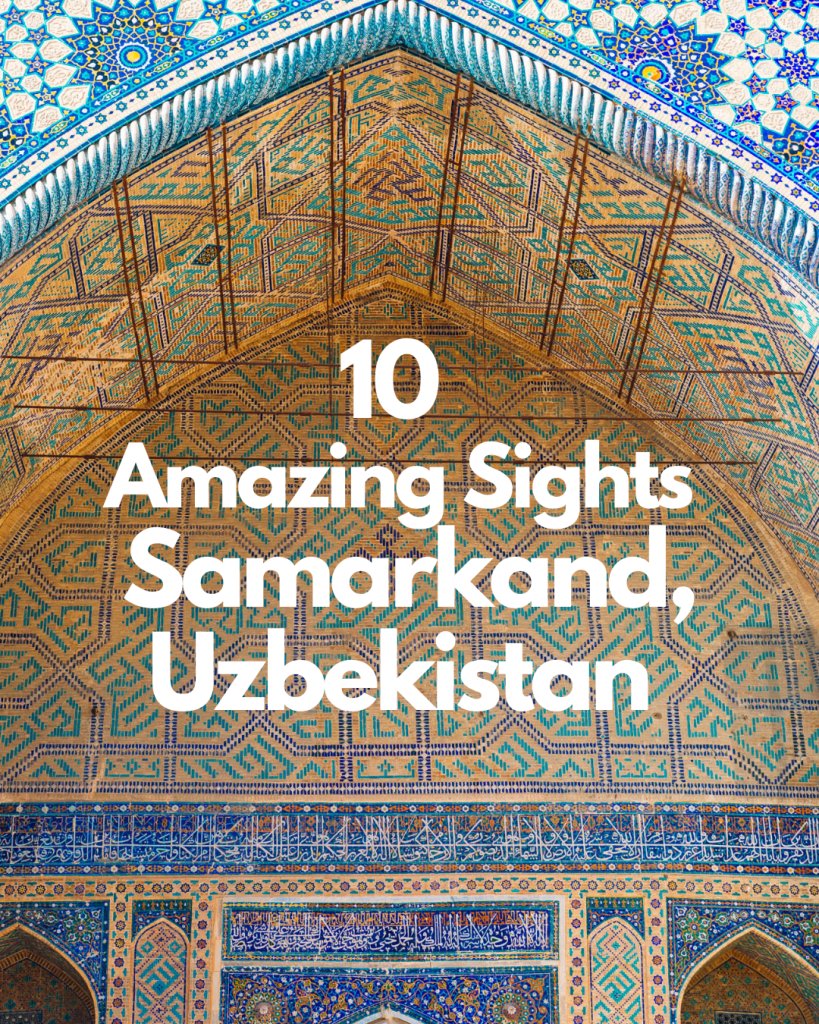
10 Top Places to See in Samarkand, Uzbekistan
1. Visit The Registan
When browsing any list of the best things to do in Samarkand, a visit to the magnificent Registan will undoubtedly rank number one.
And rightly so.
Dubbed by Lonely Planet as one of the most stunning sights in Central Asia, the Registan is a towering complex of madrassas, each decorated in dizzying azure mosaics, majolica and glittering turrets. Home to one of the oldest preserved madrassas in the world (or Islamic school), this awe-inspiring space is the highlight of any trip to Samarkand.
The three main buildings that make up the Registan are: the Ulugbek Madrassa, the Tilla-Kari Madrassa and the Sher Dor (Lion) Madrassa.
The Ulugbek Madrassa is the oldest of the trio, and was designed by the famous Ulugbek himself – one of Islam’s greatest astronomers. Indeed, it’s widely believed he taught maths at this particular madrassa in 1420.
Having survived a number of earthquakes (and consequently been repaired in the Soviet period), this colossal building was easily my favourite of all the madrassas.
Adorned with stars and housing individual lecture halls where maths, theology, astronomy and philosophy would have once been taught, this mighty building also has its own mosque and beautiful sunlit courtyard.
There is also a little cafe on the first floor of the courtyard, accessible via a (very steep) set of stairs. This tiny spot is situated in one of the ‘hujras’, or former student ‘cells’, and is a great spot for a cup of coffee.
If you ask nicely, and pay 10k SOM, the security guards may even take you up one of the turrets, for an incredible view across the building.
Definitely be sure to visit Tilla-Kari Madrassa (or ‘gold covered’ madrassa), if only for its glittering mosque. Intended to represent Samarkand’s fantastical wealth, this mosque is perhaps the most glamorous I’ve ever visited – and is covered, floor to ceiling, in gold leaf.
It’s absolutely one of the top places to see in Samarkand.
Entry to the Registan costs 100k SOM, but your ticket can be used all day for multiple entries (there is a fantastic light display here at night). Just be sure to tell the security guards you’ll be returning, so that they don’t tear your ticket.
2. Shah-i-Zinda
When searching Instagram for the best things to see in Samarkand, one place came up time and time again.
The blue-hued Shah-i-Zinda.
Boasting some of the most dazzling and intricate mosaics in the Muslim world, Shah-i-Zinda is a holy site; a long corridor of ancient mausoleums dedicated to some of the most beloved and important names in Islam.
The site was likely originally built for Qutham ibn-Abbas, who died in the 7th Century having brought Islam to Central Asia. His shrine is at the heart of the complex and carries the name of the entire site, meaning ‘Tomb of the Living King’.
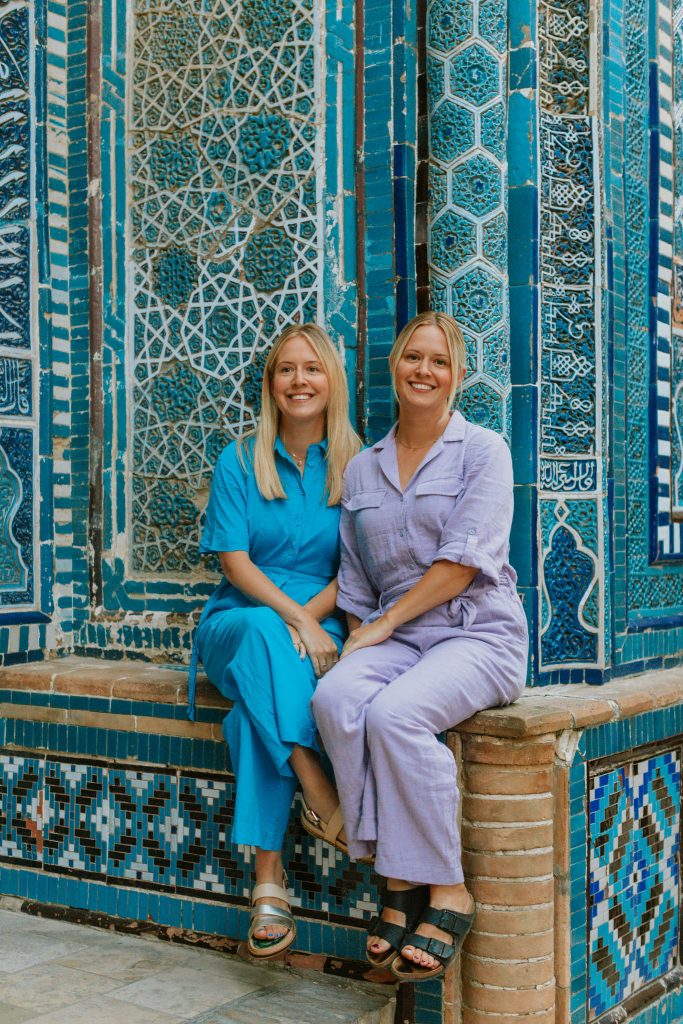
This spot is now a tourist hot spot and not just for its beauty. Indeed, it remains an important and sacred religious site. As such, it’s important to wear a headscarf here (if female) and to dress appropriately, ensuring ankles and shoulders are covered at all times.
We were told that the most beautiful shrine here was the Shodi Mulk Oko Mausoleum (1372), built for Timur’s sister and niece. The terracotta detail on this tomb is stunning – and reflects the opulence of the Timurid Era.
In terms of entry, it costs 20,000 SOM to enter Shah-i-Zinda, although this price did seem to fluctuate dependent on who you were visiting with (e.g. our tour guide arranged our tickets and got them fairly cheaply, but other single travellers seemed to be charged more).
This is one of the most beautiful places I’ve (ever) visited and definitely one of the top things to see in Samarkand.
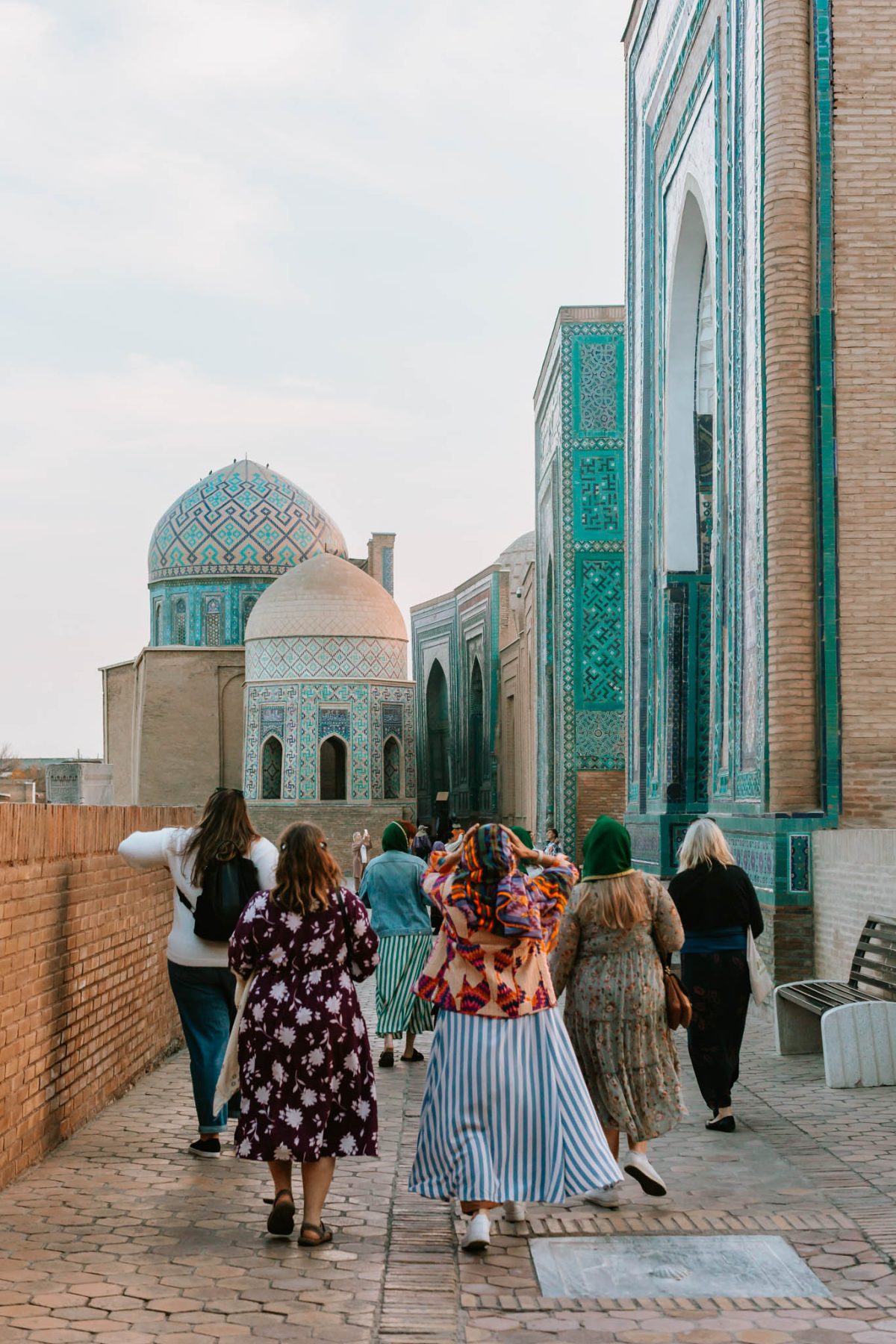
3. Meris Paper Mill (Konigil)
Now, although not strictly inside the city, one great place we visited during our two days in Samarkand was the Meris Paper Mill.
Located in Konigil, just outside of Samarkand, this historic mill and emerging tourist village provides an insight into one of Samarkand’s most important products – paper.
Now, I know this doesn’t (initially) sound the most exciting of destinations, but it is a genuinely fascinating place – allowing visitors to watch as craftsman use Mulberry bark to craft beautiful sheets of paper (and art work).
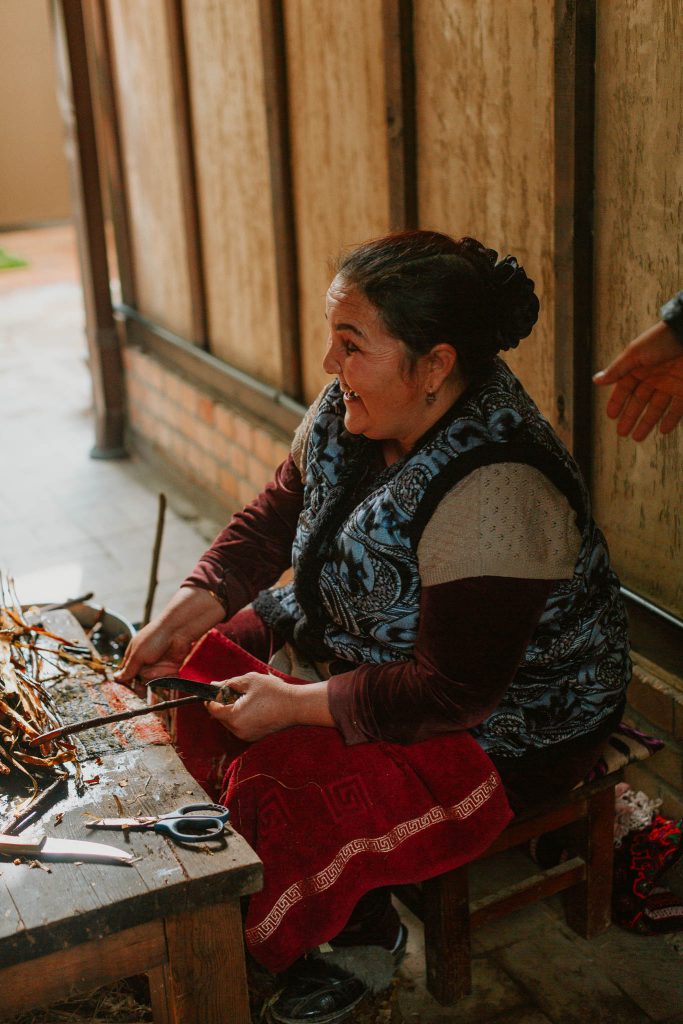 Paper has been important to Samarkand since it was invaded by the Chinese in 751 and (or so the story goes), Chinese prisoners of war shared their paper-making techniques with their captors.
Paper has been important to Samarkand since it was invaded by the Chinese in 751 and (or so the story goes), Chinese prisoners of war shared their paper-making techniques with their captors.
Other local arts and crafts are also represented here: there’s a fantastic pottery and ceramics studio (with a great shop), a gift shop to buy paper-based products, and the chance to watch traditional oil-extraction.
The setting of the village is very peaceful and serene, surrounded by foot bridges, the babbling River Siab and manicured gardens. It looked as though they were expanding this village when we visited; including an outdoor kitchen and wood-burning stove for cookery demonstrations.
It costs 10,000 SOM to enter the village and for 25,000 SOM you can join a hands-on paper making masterclass. It’s a great place to pick up some high-quality souvenirs and to relax after pounding the pavements of Samarkand.
Although not strictly falling under best things to see in Samarkand, a trip to this serene little spot comes highly recommended, nonetheless.
4. Dinner at Platan Restaurant
When it comes to the best restaurant in Samarkand, or the best place to eat in Samarkand, we can definitely recommend the wonderful Platan.
We booked here as we wanted a ‘special’ group meal to celebrate the end of our week in Uzbekistan. Researching the best restaurants in Samarkand, we noticed that this spot was mentioned regularly – and so managed to bag ourselves a table for that night.
Set inside a beautifully lit wood and stone building, this restaurant serves both European and Uzbek dishes.
We were seated inside the restaurant’s wood panelled library, which was a beautiful spot to enjoy a fantastic meal. The Uzbek dishes here were a noticeable notch above the traditional dishes we’d tried elsewhere, and there was live music (from a piano).
It was definitely pricier than the other restaurants we had visited, but no more than £20 a head for three courses and wine (a bargain by UK standards).
5. Wander Gur-e-Amir Mausoleum
Another big-hitter when it comes to top things to see in Samarkand is the, quite frankly, enormous Gur-e-Amir Mausoleum (or ‘Tomb of the King’ in Persian).
Built to honour Uzbekistan’s biggest star, Timur, this grand mausoleum was built in the 14th century and has been dominating the city’s skyline ever since.
Considered a masterpiece in Persian architecture, the building had enormous influence across the empire, inspiring the design of the Gardens of Babur in Kabul, the Taj Mahal and Humayun’s Tomb in Delhi.
Timur’s body lies beneath the mausoleum and it’s a spot that comes with an interesting legacy.
During Soviet rule, scientists wanted to open Timur’s tomb – much to the horror of local leaders. Indeed, they were adamant that if the tomb was opened, a curse would be unleashed over the city – a threat even inscribed on Timur’s own tomb. These words warned: ‘when I rise from the dead, the world shall tremble’ and ‘whosoever disturbs my tomb will unleash an invader more terrible than I’.
Eventually, and despite this foreboding warning, Timur’s tomb was opened in 1941, just two days before the Nazis invaded the Soviet Union. As a result, Stalin believed it was the curse that may have caused this invasion and he demanded the immediate reburial of Timur on 20 December 1942.
Spooky stuff.
For those wishing to visit, it costs around £3 to enter the Mausoleum.
6. Drop by the Towering Bibi-Khanym Mosque
When it comes to the best things to do in Samarkand, you’ll notice a theme – and that’s visiting the city’s impressive mosques.
Bibi-Khanym Mosque will top most lists of top things to see in Samarkand and it’s fairly obvious why.
Built in 1399, legend has it that this magnificent mosque was built on the instruction of one of Timur’s ‘favourite’ wives – princess Bibi-Khanym. She had wanted the building to celebrate and reflect Timur’s military prowess and success across India – making it one of the most spectacular buildings in the Muslim world.
Today, the mosque still welcomes worshippers alongside international visitors, and it costs 30,000 SOM to enter (around £3).
Sadly, much of the mosque was destroyed by Uzbekistan’s catastrophic earthquake in 1897 and it fell into disrepair following the fall of Timur’s Empire. However, the building was restored by the Soviets in the 1970s (perhaps a little too earnestly) and whilst not as spectacular as it might have once been, it is still a must-see.
7. Souvenir Shop in Siab Bazaar
Having shopped up a storm in Bukhara, we were keen to indulge in some retail therapy in Samarkand, with a trip to the city’s largest bazaar – Siab.
Now, I’ll admit that from the outset, I wasn’t as impressed by this particular bazaar as I was with the pretty markets you’ll find in Bukhara. However, this busy market really is for the locals – a large space filled with food, spices and plates of elaborately wrapped candy.
It was pouring with rain when we visited, which may not have helped things, and a freezing wind swept through the long alleyways of the bazaar.
Despite this, it was still a great place to explore and we managed to get some relatively cheap ceramics (cheaper than those in Bukhara), while people watching. This is largely an agricultural bazaar – or ‘dekhkan’ bazaar – meaning families largely pop here to stock up on piles of vegetables, grains and rice.
We were thrilled to discover that this particular bazaar sells over 17 different types of famous Uzbek bread – and were invited to try each (an invitation that we definitely exploited).
The market is laid out in neatly themed rows and is therefore very easy to navigate. Feel free to try to barter prices down, if you wish.
8. Explore Ancient Afrasiab
As I mentioned at the start of this list of top places to see in Samarkand, the history of this city is incredibly rich and diverse; mind-bogglingly so, in fact.
The first stones of the city were laid in the 8th-7th Century BC by the Sodigans and were perched on the Afrasiab Hill. Once heavily fortified and surrounded by a large wall, the city was extensive – spanning some 200 HA.
Today, this former ancient city can be visited, thanks to decades of excavation. Thankfully, the site has its own museum, which is definitely needed as – unless you have a qualification in ancient archaeology – it’s difficult to decipher what is what.
The museum itself is really interesting, albeit small, and includes relics found from the Sodigan settlement – some 1,400 years ago. There are also some spectacular frescoes definitely worth checking out.
9. Join a Samarkand Wine Tasting Tour
When it comes to visiting Uzbekistan, or Samarkand in particular, one thing I hadn’t expected were the wine tours on offer.
Uzbekistan is something of a celebrity when it comes to Central Asian wines, with wine production really starting during the Soviet period. Thanks to the country’s fertile soil and the introduction of the Kuldzhin grape variety, the wine made here is sweet and dry – making it very popular.
One great wine tour in Samarkand takes visitors to the nearby Khovrenko Winery, which is very popular with tourists. Here, guests can try more than a few tipples – sampling eight wines, ‘balzams’ (medicinal liqueur) and cognacs, before having a quick peek around the attached museum.
The museum is free to enter, although prices for the tours seem to fluctuate, depending on where and how you book it. Rather than booking online via sites such as Viator, I’d definitely recommend visiting the museum and asking about wine tasting on the day, to save yourself some money (I saw some reviews claiming people were being charged up to $20 for the tour – which is very high by Uzbekistan standards).
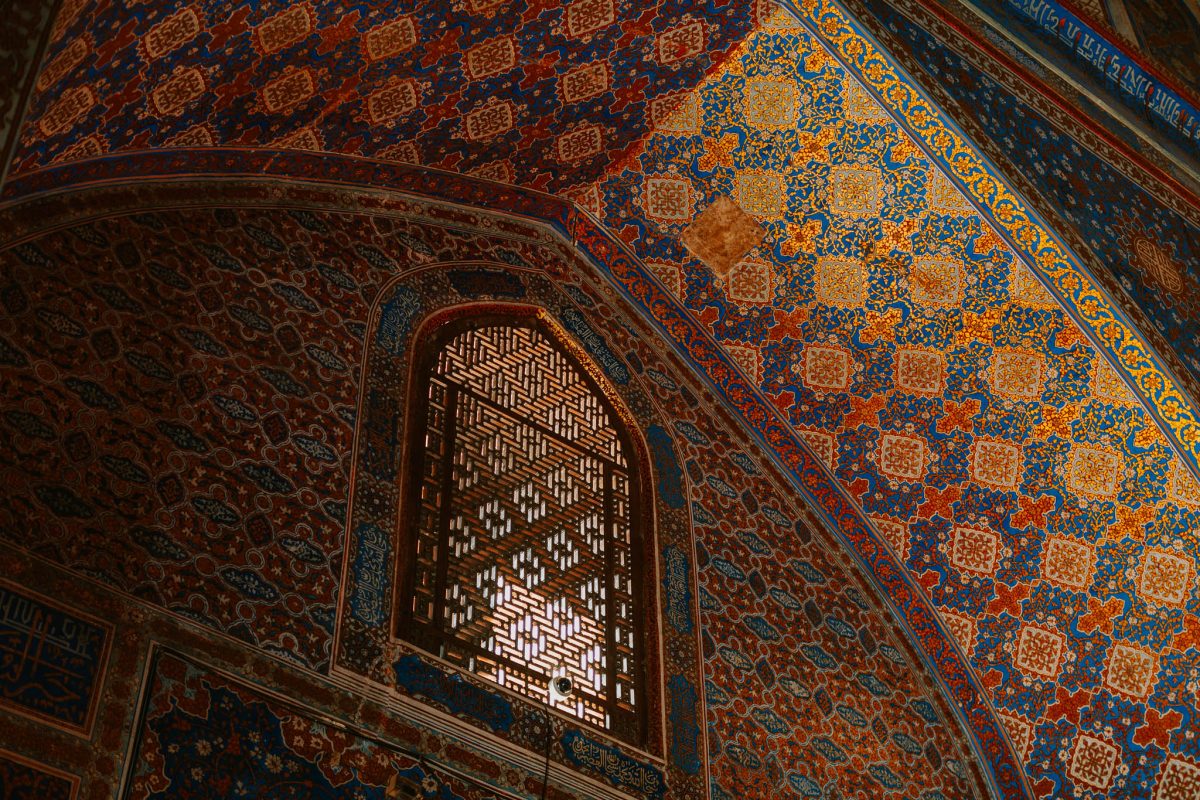
10. Watch a Traditional Music Performance at the Registan
As dusk settles over Samarkand, the city’s famous Registan comes to life – with music, dancing and celebrations taking place throughout the evening.
Firstly, if you visited the Registan during the day, remember that you can use your ticket again come evening time, provided it hasn’t been torn by a security guard (you shouldn’t have to pay twice for your entry).
Definitely be sure to arrive after 7pm, when the sun has set and the light show begins; illuminating the city’s most iconic buildings a rainbow of colours. Throughout peak season, there is also often live music and dancing, with ladies twirling in vibrant traditional dresses as they perform the country’s famous (and UNESECO honoured) dance – the Khorezm Lazgi.
Come night time, this place is definitely one of the top places to see in Samarkand.
Other cultural shows are regularly put on throughout the warmer seasons in the Registan, so definitely check what might be on each night (you can ask the security guards, or tourist police).
Final Thoughts: Is Samarkand Worth Visiting?
Before visiting Samarkand- one of the world’s oldest cities – I was certain it would be my favourite stop on our Silk Road tour.
Boasting vast, glittering buildings, imposing palaces and sweeping boulevards, Samarkand is often touted as one of the most impressive cities in Central Asia.
It’s difficult to disagree.
Filled with stunning architecture and a history that spans thousands of years, a visit to Samarkand is both fascinating and surreal. It’s here that people and cultures have mixed and clashed for centuries; one of the globe’s oldest continuously inhabited cities. Although much of ancient Samarkand has now been aggressively restored, it does still remain a true spectacle; a testament to the splendour and awe of the empires that built it.
In terms of top places to see in Samarkand, you’ll be spoilt for choice. Walk the city’s leafy boulevards and architectural giants will appear regularly, and without fanfare, from behind ancient oak trees and on street corners.
It’s a big city, an impressive city – a city to be wowed by.
However, was it my favourite city in Uzbekistan? Probably not.
When it comes to which is nicer, Samarkand or Bukhara, I would definitely say Bukhara. Although not home to quite so many skyline dominating buildings, there is something about Bukhara that is more charming – a more modest and unassuming sort of place.
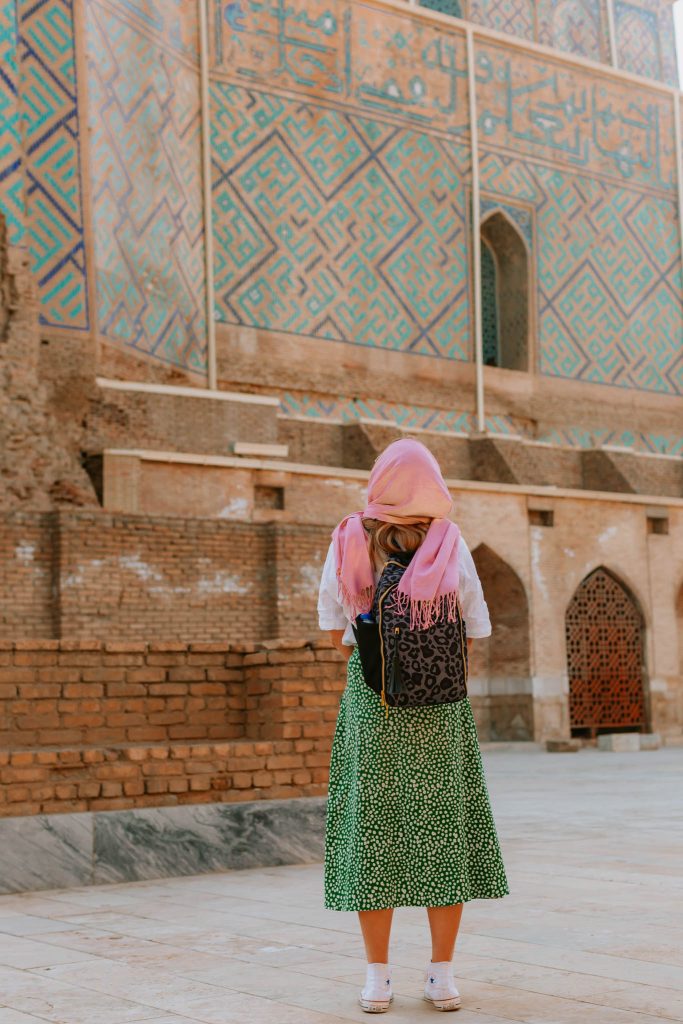
I was surprised by the size and freneticism of Samarkand – the noisy dual carriageways that ploughed through the city and its disparate neighbourhoods. Yet, perhaps that was my ignorance. Perhaps I had assumed Samarkand would be a genteel fortress city like Bukhara or Khiva, entirely forgetting that it has been a buzzing metropolis for thousands of years.
Overall, if you’re wondering if Samarkand is worth visiting – then absolutely, yes it is. This city is home to a ‘who’s who’ of Uzbek architecture, mausoleums and mosques -and is full of Central Asia’s headline acts.
And, whilst it perhaps wasn’t my favourite place in Uzbekistan, it wouldn’t be a city that I’d want to miss.












